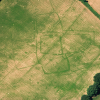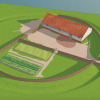
Recent heatwave reveals historic farm
This summer’s hot, dry weather has revealed cropmarks in a field in Bicton that show a Romano-British farmstead once stood there.
Aerial photography of the farmstead, originally discovered by former Devon County Archaeologist Frances Griffith in 1984, has been released by Historic England.
The cropmarks suggest the field in Bicton may have contained farm buildings surrounded by fields and paddocks.
It is likely the farm dates back to the pre-Roman Iron Age and that the cropmarks reflect more than one phase of activity, including from Romano-British times.
Ground and aerial archaeological work from the late 1960s onwards has shown widespread Roman influence in Devon, including a Roman fort at Okehampton, a road from Exeter to North Tawton and Okehampton, a villa at Crediton and hundreds of rural farmsteads.
Many Romano-British and prehistoric farmsteads have been fully or partly excavated, producing detailed evidence from pottery, coinage and other artefacts that give more accurate dating to the sites and help archaeologists understand the lives of people nearly 2000 years ago.
Heatwaves are particularly good for aerial archaeology as cropmarks are caused by dry soil not providing enough water for crops.
When this occurs, buried ditches and foundation trenches provide moisture, so crops grow taller and denser whilst buried walls cause the crop to parch prematurely.
Aerial photography helps Devon County Council’s Historic Environment team ensure that archaeological excavations take place before development occurs in an area.
Academic research is also focused on these sites, such as the Mount Folly Project, investigating a coastal settlement in the South Hams, and the Exeter University-run training and community dig at Ipplepen.
Bill Horner, Devon County Archaeologist, said: “The discovery of new sites and the recording of new evidence about known sites through aerial survey has been vitally important for advancing understanding of Devon’s rich archaeological heritage. Many hundreds of new sites of prehistoric, Roman and medieval date have been discovered by aerial archaeologists since the mid-1970s.
“You have to be in the right place at the right time to make such discoveries and we are fortunate that Historic England have been able to take to the air over Devon and have captured such excellent photos of the sites revealed by this year’s exceptionally dry conditions.”
Duncan Wilson, Chief Executive of Historic England said: “This spell of very hot weather has provided the perfect conditions for our aerial archaeologists to ‘see beneath the soil’ as cropmarks are much better defined when the soil has less moisture. The discovery of ancient farms, settlements and Neolithic cursus monuments is exciting. The exceptional weather has opened up whole areas at once rather than just one or two fields and it has been fascinating to see so many traces of our past graphically revealed.”
Helen Winton, Historic England Aerial Investigation and Mapping Manager said: “This is the first potential bumper year in what feels like a long time. It is very exciting to have hot weather for this long. 2011 was the last time we had an exceptional year when we discovered over 1,500 sites, with most on the claylands of eastern England.”
Damian Grady, Historic England Aerial Reconnaissance Manager said: “This has been one of my busiest summers in 20 years of flying and it is has been very rewarding making discoveries in areas that do not normally reveal cropmarks.”



















